In this explainer video, AgriSolar Clearinghouse Director Stacie Peterson offers up five things to know about agrisolar and crops.
Tag Archive for: solar farming
his work simulates the behavior of solar irradiance and its interaction with photovoltaic panels and the crop, as well as possible shading, in a photovoltaic plant to study its potential reconversion into an agrivoltaic installation.
By Stacie Peterson, PhD, NCAT; and Heidi Kolbeck-Urlacher, Center for Rural Affairs
March 2024
Agrisolar practices, also called agrivoltaics, are the co-location of agriculture and solar within the landscape. They include solar co-located with crops, grazing, beekeeping, pollinator habitat, aquaculture, and farm or dairy processing. Agrisolar practices offer an opportunity to allow solar and agriculture to co-exist while meeting demands for clean energy and resilient rural infrastructure. One agrisolar approach is crop production under and adjacent to solar photovoltaics. Farms and research sites across the country demonstrate agrisolar as an opportunity to diversify farm revenue, decrease crop irrigation, increase crop yield, increase soil moisture, improve solar panel efficiency, and increase rural energy independence (Barron-Gafford, 2019; MacKnick, 2022; and Adeh, 2019).
Extreme heat and weather events from climate change, including the long-term drought in the American west, have led to water shortages, decreased crop yields, and increased heat stress for farm workers. Climate projections show this trend continuing, resulting in a marked decrease in crop yield in the future (Hsiagn, 2017). At the same time, an increasing population has elevated the need for nutritious local foods and food sovereignty.
Colorado Governor Announces Agrivoltaic Funding
“Colorado governor Polis and Colorado Department of Agriculture (CDA) Commissioner Kate Greenberg awarded $500,000 in grants to seven projects that demonstrate the use and benefits of agrivoltaics, the simultaneous use of land for solar energy production and agriculture. These grants distributed by the Polis administration will provide funding to incorporate innovative technology that supports Colorado’s producers to operate in the face of challenges created by climate change and prepare the next generation.” – Colorado.gov
Sarah Bendok Receives Permit to Build Agrisolar Project in Phoenix
Sarah Bendok has received the permits by the city of Phoenix required to proceed with constructing a 5-KW agrivoltaic system. The project is expected to cost around $20,000 and is financed through donations from community events, presentations and grants. Sarah is the founder of the non-profit Growing Green, where they help local farmers develop, implement and fund sustainable technologies.
Learn more about Growing Green here.
Agrisolar Benefits Farmlands and Local Economies
“Smaller residential solar arrays, owned by the landowner, can significantly reduce the electricity bills of a farm, often covering the electricity needs of barns, warehouses, equipment, and the household.
Michigan State University found that a 10 kilowatt (kW) solar system could save the average farm about $1,880 per year. Other farms, like dairy farms, have a more energy intensive operation and the same 10 kW system could save a dairy farm nearly $4,000 per year. Combined with federal incentives and USDA rural energy programs, farms can save even more on upfront costs.
Lightsource bp’s Elm Branch and Briar Creek solar projects in Texas delivered two new revenue streams to local farmers. The first was in the form of lease payments. The second was a grazing contract for the farmers’ more than 1,000 sheep. These sheep now control the growth of grass on the site and stay cool under the shade of the panels.” – Cleantechnica
Agrisolar: The Key to a Clean Energy Future
“Interest in agrivoltaics is growing, along with the need for land for new solar farms, as Minnesota and the nation shift to cleaner energy. The U.S. Department of Energy estimates 10 million acres of solar panels will be needed by 2050 to meet the nation’s net zero-carbon goals.
US Solar owns the 1-megawatt Big Lake community solar garden and about 80 more in Minnesota. It’s part of a pilot project encouraging farmers to grow crops or graze livestock between and underneath solar arrays.” – MPR News
Oil Companies Lightsource and Shell Using Agrisolar
“Today, the U.S. has about five gigawatts of agrivoltaic projects, encompassing more than 35,000 acres across over 30 different states. While this only represents about 3% of the country’s installed solar capacity, it’s a growing industry, and farmers are taking note.
Lightsource operates a combined 615 megawatts of sheep grazing and solar power projects, around 12% of the nation’s entire agrivoltaic portfolio. The company plans to add an additional 1,058 megawatts worth of projects next year. Shell is also involved in the space through its 44% stake in solar developer Silicon Ranch. The ranch operates 1,300 megawatts of agrivoltaic projects with an additional 900 megawatts planned over the next two years.
While there are other players in the domestic agrivoltaic market such as Enel Green Power and US Solar, Lightsource and Silicon Ranch remain the largest players in the space. American oil majors such as Chevron and Exxon haven’t invested in agrivoltaics.” – CNBC
ENEL and ENEA Develop Microalgae Agrisolar System
“ENEA and Enel have developed an ‘algovoltaic’ system to cultivate high-value microalgae, ranging from €100 ($106.19)/kg to €600/kg for pharmaceutical uses or cosmetic purposes. This is possible due to the integration of a fully automated cultivation system with a 7-kW solar array.
The system allows the cultivation of microalgae with a high commercial value, from €100/kg to €600/kg for pharmaceutical or cosmetic use, through a fully automated cultivation system integrated with the solar array.” – PV Magazine
Iowa State University Develops Agrisolar Project to Study Land Use
“Iowa State University (ISU) is embarking on a research project to explore the combination of crops and solar power. The Alliant Solar Farm at Iowa State University is a groundbreaking agrivoltaics research project merging solar power generation and agriculture to study how best to optimize land use while providing local community benefits. The array was inaugurated on Thursday, October 19th with a ribbon-cutting ceremony.” – prnewswire
New Chinese Agrisolar Design Accommodates Farming Equipment
“Researchers in China have built a 10 kW spectral-splitting concentrator agrivoltaic system that accommodates small farming equipment below it. The installation relies on 128 concentrator modules integrating each an ultra-white and toughened concentrating curved glass (CCG), a multilayer polymer film (MPF) and 23%-efficient interdigitated-back contact (IBC) crystalline silicon solar cells provided by Sunpower.” – PV Magazine
As we strive for climate change solutions, competition over land for food production or clean energy production is an emerging challenge to address this challenge, demonstrations of systems that produce energy and food on the same land are needed to usher in solution-scale adoption of these practices. A new research project at the University of Delaware (UD) will study the results of growing food crops underneath uniquely designed PV solar arrays. SolAgra Corporation will oversee the installation of two solar arrays at the UD Newark and Georgetown campuses. Once built, these sites will have the potential to demonstrate just how symbiotic solar energy and agricultural production can be.
Professors Steven Hegedus, UD Department of Electrical and Computer Engineering, Gordon Johnson of the Plant and Soil Sciences Department, and Emmalea Ernest, Agriculture Program Leader, will work with their students to investigate the potential benefits to food crops grown beneath the PV arrays. All the preliminary engineering studies for the project are completed and approved, and construction is on track to be completed by the start of the growing season in April 2024. UD will fund the installation of the solar arrays and the initial crop plantings underneath. Further funding from the US Department of Agriculture and the US Department of Energy is being pursued to sustain a multiyear study of the sites.
Barry Sgarrella, founder and CEO of SolAgra, said he developed the raised solar platform that will be used in the UD project to “help farm families be more profitable and to slow the trend of farmland being consumed by commercial development.” The SolAgra Farming Array™ will consist of elevated array segments with 15.5 feet of clearance to accommodate the tallest agricultural equipment. The racking will be assembled and the solar panels installed at ground level and then hinged into an upright position.
The panels will track the sun to increase energy production by as much as 15% and, when needed, they can be rotated so the panel edge is perpendicular to the sun to allow the maximum amount of sunlight to hit the crops below, a function Sgarrella calls CounterTracking™. This, coupled with the unique ability to shift the entire array east or west, called DynamicShifting™, will deliver varying degrees of sunlight or shade to crops planted below as needed. The rows of solar modules will be installed on 11.25-foot centers, a relatively dense panel row spacing for agrisolar cropping applications.
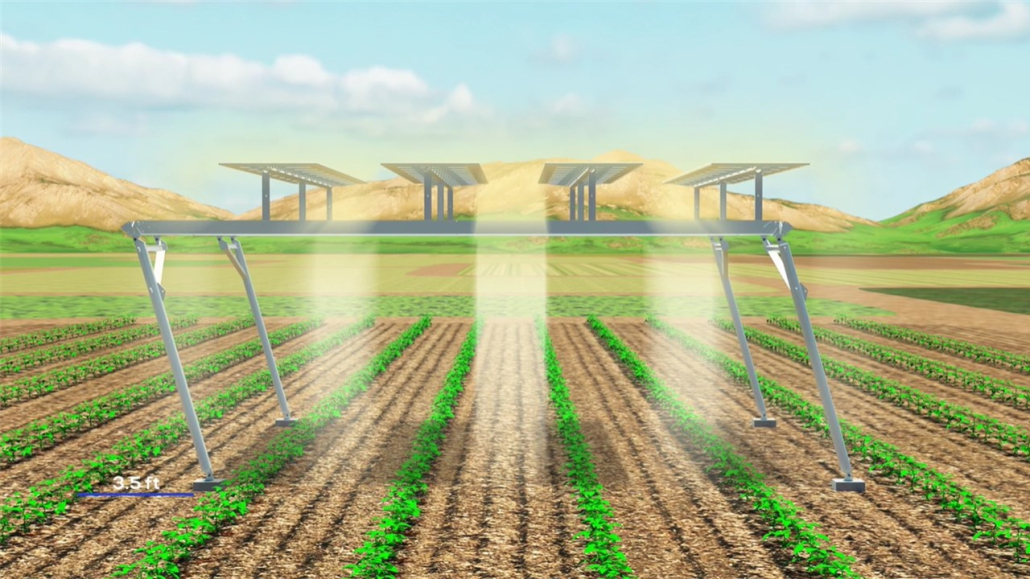
Dynamic Shifting allows the entire array to move side to side for the least amount of shading possible.
Each array segment will be 35 by 45 feet and is designed to hold enough solar panels to produce 17 kW of electricity. The array segments will be modular and can be scaled up to much larger size arrays. Each research site at the UD project will contain two array segments totaling 68 kW of installed solar panels. The two systems will be identical except that the array installed on the Newark campus will house bifacial solar panels to study how much electric production can be gained from light reflecting off the crops and ground back to the underside of the panels. Sgarrella stated that the cost to install a segment is comparable to other raised-platform solar arrays of the same size, and costs would decrease for larger installations as economy of scale is achieved.
According to Professor Hegedus, part of the research will involve looking at crop production at different shading levels. Photo saturation is the point at which plants cannot efficiently utilize more sunlight in the photosynthesis process and once the crops are at that point, it makes sense to utilize the light for energy production. The crops that will be included in this study are strawberries, tomatoes, peppers, and lettuce and were chosen because of their high market value. The flexibility of the SolAgra Farming Array™ design will allow the researchers, through controls on their smart phone or tablet, to provide full sun, full shade, or anything in between based on individual crop needs. The results can then be used to help develop shading schedule algorithms that can control the system for different crops.
Sensors will be used to measure direct and diffuse illumination under the panels, soil and air temperatures, humidity, and crop temperatures to start quantifying crop benefits. It’s expected that the soil in the shade of the panels will retain moisture and that the crops will require less irrigation, which has been shown as a benefit of agrivoltaic cropping systems in other research.
The researchers will also orient the panels horizontally to test the system’s ability to protect crops from severe weather like rain or hale. Even in this horizontal “umbrella” position, the panels will be able to produce 80% of their rated power. The benefits of protecting crops from damaging hail and heavy rain are evident, but many crops could benefit from the protection and shade control this system could offer. For example, this system could protect against sunscald, which can affect most crops in the right conditions and render them unmarketable. And, if grape growers could control sun levels, they could affect the acidity and sugar levels of the grape, which is very important in wine production. Many crops could benefit if growers could protect them with a solar panel covering, especially as weather conditions become more extreme.
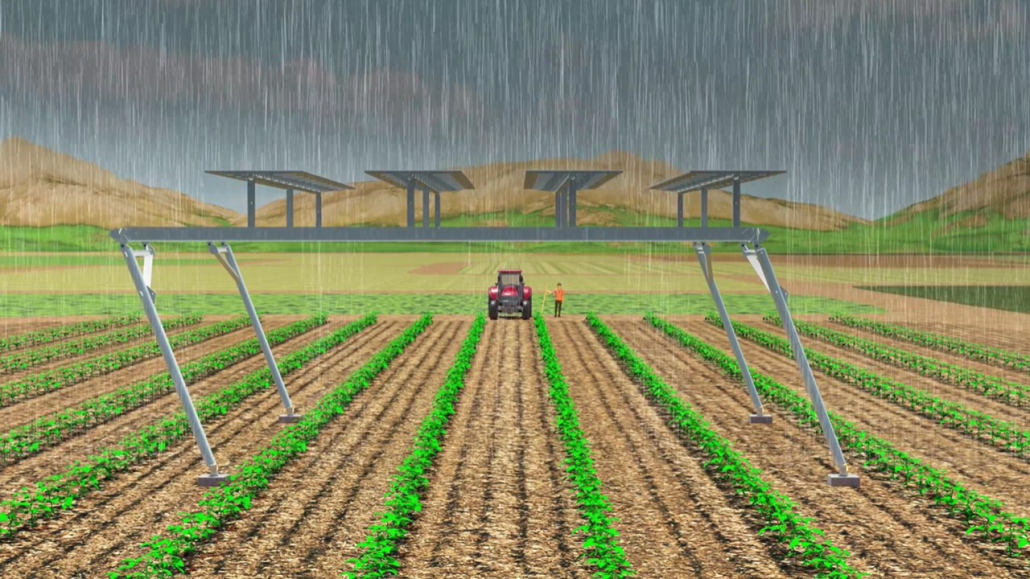
An umbrella effect is created when the solar panels are placed in a horizontal position and shifted over the top of each crop row.
Professor Hegedus believes that one of the biggest indirect benefits of proving this type of agrisolar system is that opposition to large solar installations on farmland might dissipate once neighbors realize that farming is not being replaced by solar panels but rather augmenting with an additional layer of income. He said, “farming is just carbon-based solar energy so now we’re combining two different ways of harvesting that energy.”
The project’s researchers will be challenged by the quantity of data gathered from multiple sensors over a nine-month growing season at two locations. Advanced data analytic techniques will be necessary to organize and effectively interpret all the information. Future work will utilize the results from the study to form shading schedules that are tuned to each geographic and climate region to accommodate sun angle changes and local weather conditions so that the technology can be effectively utilized by farmers.
In the face of climate change, well-designed agrisolar systems may give farmers a better chance to stay in business. Having the ability to protect crops and to control the shade levels could optimize production while at the same time producing revenue from solar power production, keeping farmland in production and profitable. Applications of this technology will be studied at UD in the coming years over the course of this project.
Photos courtesy of Solagra.
USDA Joins Great Plains Institute and Big River Farms in Minnesota Agrisolar Project
“Officials from the U.S. Department of Agriculture (USDA) joined Great Plains Institute (GPI) and Big River Farms announced GPI and Big River Farms’ ‘Solar Farmland Access for Emerging Farmers’ demonstration projects alongside project partners Connexus Energy and US Solar. As the country and Minnesota both take steps to convert our energy supply to be derived from carbon-free sources, this pilot project is setting out to solve for how solar energy development can be increased while also preserving agricultural land for the people who grow the state and nation’s food.
Funded by the Mortenson Family Foundation and with additional support from the National Renewable Energy Lab (NREL) and Argonne National Lab, these agrivoltaics projects aim to demonstrate safe and scalable operational practices for electric cooperatives and solar site owners to provide farmland access for emerging farmers inside the fence of solar facilities.” – Globenewswire.com
AgriSolar Clearinghouse’s Follow the Sun Tour Visits Oregon
The AgriSolar Clearinghouse’s Follow the Sun Tour visited the North Willamette Research and Extension Center in Aurora, Oregon, on September 18, 2023. The research center hosts an agrivoltaic project, where the University of Oregon studies combining crops and solar energy on the same parcel of land. Event attendees participated in a tour of the agrivoltaic site, guided by lead researcher Dr. Chad Higgins. After the tour, everyone enjoyed a lunch and round-table discussion in the conference room of the facility.
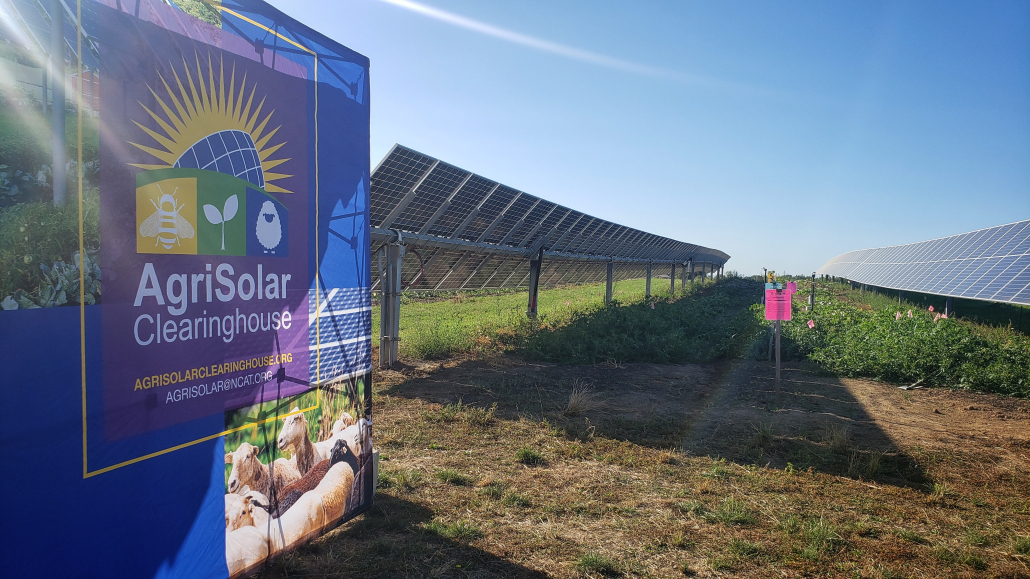
The research conducted at the facility includes showing that solar arrays could be used as resources for plant productivity and that solar panels on agricultural lands maximizes their efficiency. Attendees discussed details related to these studies during the tour, which also included financial questions and scalability.
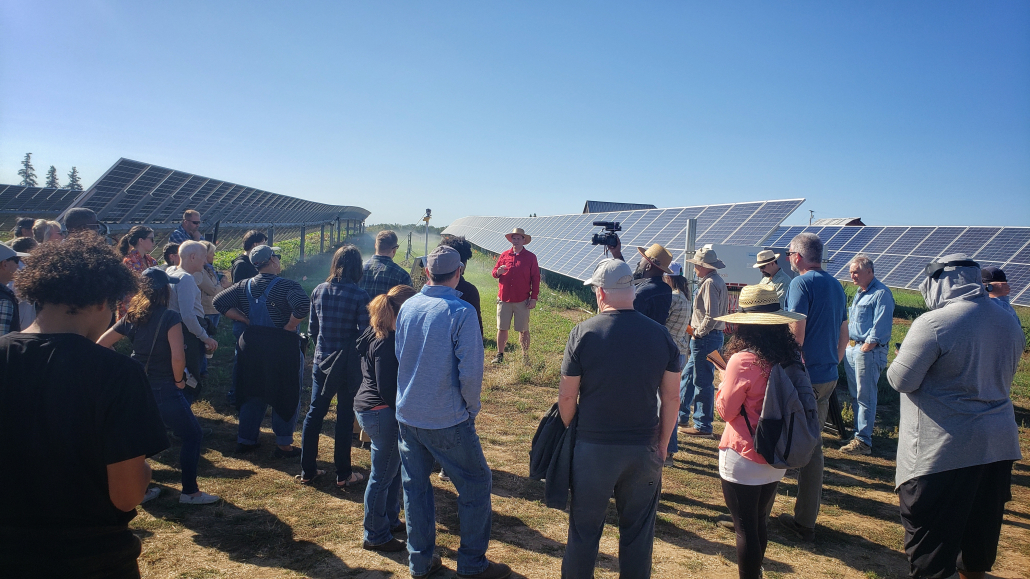
Blue Wave in MA Secures $91 Million for Agrisolar Development
“Northeast U.S. solar developer and operator BlueWave received $91 million in financing, which the company says will allow it to achieve long-term ownership and management of its portfolio of projects.
The financing will go toward the construction of five projects featuring dual-use solar development attributes, called agrivoltaics, in Massachusetts. These projects are “strategically implemented to benefit all parties impacted by the projects,” including landowners, farmers and the surrounding community, according to BlueWave. The financing includes a $64 million debt raise with KeyBank, and $27 million tax equity raise with U.S. Bancorp Impact Finance.”– PV Magazine
Wisconsin Bill Introduces the Protecting Future Farmland Act
“U.S. Senators Tammy Baldwin (D-WI) and Chuck Grassley (R-IA) introduced the Protecting Future Farmland Act, new legislation to support farmers’ land stewardship efforts as many choose to deploy solar energy on their land. The legislation will ensure that federal investment in rural energy projects prioritizes both land stewardship and responsible deployment of renewable energy to protect America’s farmlands for future cultivation.” Senate.gov
This report updates readers on new research in dual-use solar and explores important considerations for the implementation of dual-use solar in the Pacific Northwest region. In the last few years, new findings suggest there are many environmental and economic benefits of creating multi functional systems that combine and prioritize multiple land uses. New research of dual-use solar facilities shows increased yields in some crops and decreased water needs; benefits to grazing animals such as decreased heat stress; improved ecosystem services such as better water quality, erosion control, carbon storage, and pollination services; and further opportunities for dual-use implementation.
By Allen Puckett, NCAT Technical Writer
August 2023
In Ballground, Georgia, Jeffrey Whitmire and Chris Ayers, owners and operators of Chiktopia, are making use of an innovative solar technology that allows them to automate pastured poultry production while also practicing regenerative agriculture. Whitmire and Ayers, both students at the University of Georgia, produce and use fully automated solar-powered chicken coops on their operation, which they also sell to other farmers. In addition, Chicktopia provides regenerative grazing services to farmers.
These solar-powered chicken coops assist in building the topsoil (regenerative agriculture) using chickens. The self-moving, automated chicken coops makes spreading manure and flock rotations much easier for farmers and results in healthier soil with a higher level of organic matter. Chiktopia suggests that automated equipment such as these solar chicken coops are mandatory for regenerative agriculture in the future.
“At Chiktopia we believe sustainable farming practices are not only what are best for the planet but are also what create the happiest animals and the healthiest food. We help farmers minimize labor and maximize management.
Our automated chicken coops use renewable energy systems, which automate the majority of the labor in the pastured-poultry process. Whether it be for broilers or egg-layers our coop will help save you time and labor.” – Chiktopia
Chiktopia aims to help build a more resilient food system across the United States using pasture-raised poultry, says Whitmire.
The Regenerative Process
If a farmer wants a section of land to be converted into a regenerative crop farm, Chiktopia provides that service and process. The first step in the process is to put egg-laying hens on the land in the mobile, solar-powered coops. Once the hens are rotated through the whole pasture, dairy cows are then put on the land to spread more manure. This last step of the grazing process allows the soil to sustain more vegetation through increased microbe quality and carbon sequestration. This improvement in soil health is known as regenerative grazing.
Traditional Chicken Coops
A traditional chicken coop is made of steel and must be manually lifted or moved using a handle or trailer hitch on one end. This requires much more manual labor than having an automated coop. Moving these traditional coops causes the pasture to be damaged when chickens spend too much time in one spot. The mobility of the new solar-powered coop keeps the chickens from destroying the pasture and allows the organic matter in the soil to regenerate.
Solar-Powered Chicken Coops
The solar-powered chicken coops are equipped with an automated temperature-control system, automated chicken feeder, sun-tracking solar array system, automated pressurized watering system, automated egg collector, and even heat lamps for young chicks. These coops have a traditional hitch for farmers who might prefer moving the coop with ATVs or trucks, but they can also be easily moved with a handheld remote control.
When the coop moves, the birds don’t seem to mind at all. On the outside of the coup is an electrified perimeter fence that keeps the chickens in and predators out. When the hens are first put on a specific site, they spend a couple days in the coop getting comfortable with the new location, says Whitmire. They are then let out of the coop into the fencing area where they can roam.
The floor of the mobile coop is lined with plastic netting that allows the bird manure to fall to the pasture below. Feeders are aligned on the two sides of the coop above the netting where the birds tend to spend most of their time. When they aren’t feeding, there is a ladder in the center of the coop that allows the birds to get up near the ceiling and roost on installments designed for chicken roosting.
These automated, solar-powered chicken coops are available to order on Chiktopia’s website. Depending on the needs of the farmer and the design of the coop, costs can vary, ranging from $8,000 to $20,000. One coop created by Chiktopia houses up to 400 birds.
Predation Prevention and Shelter
These coops provide effective predation prevention. The sturdy cover provided by the coop protects hens from hawks and other predatory birds when they are inside. The coop’s design also reliably provides protection from harsh weather and other conditions that may make the birds uncomfortable or unsafe.
“We keep our birds protected through using strong materials on the coop and an electrified fence. Solar panels also reflect light at raptors.” – Chiktopia
Future Improvements
Chiktopia plans to make improvements to their coops, including a rainwater diverter that puts water directly into the watering tank that will be available to the chickens.
“Our birds have never been happier, and collecting eggs has never been easier! Daily movements are easy because the coop moves itself.” We were not able to move our birds on pasture before we had an automated Chiktopia coop.” – Chiktopia customer
By Allen Puckett, NCAT Technical Writer
In Harrodsburg, Kentucky, a flock of sheep is successfully grazing on a solar array at the E.W. Brown Farm, thanks to a collaboration between Shaker Village of Pleasant Hill and LG&E. This operation is Kentucky’s largest solar farm, consisting of 44,000 solar panels on 50 acres.
Shaker Village’s flock grew from 125 Shetland sheep to more than 200 sheep—with 15 ram and ewe lambs born in Spring 2023, and more expected in the near future. Of these 200 sheep, more than 50 moved to the Brown Solar facility in April of 2023.
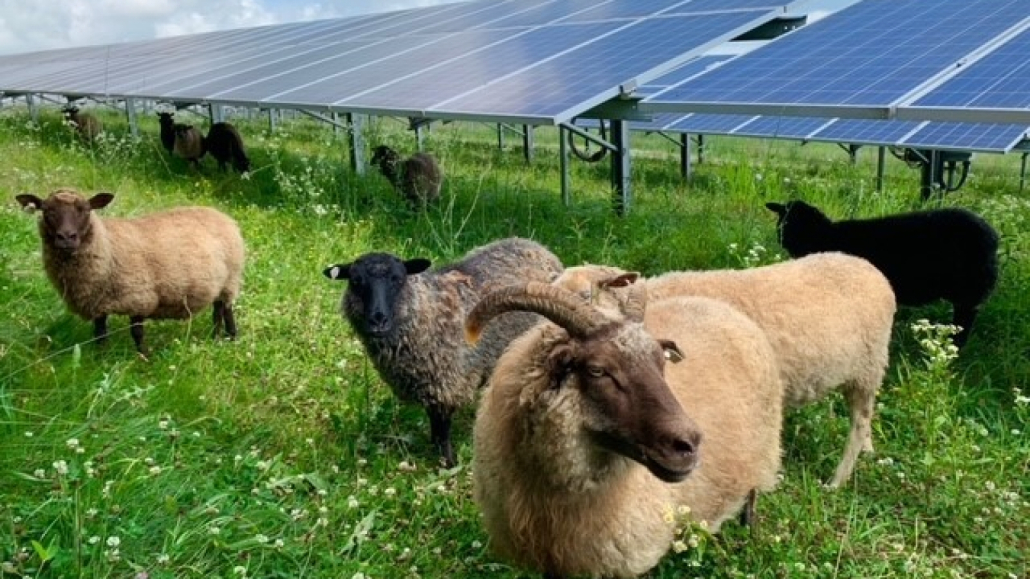
Utilizing sheep on the solar array is not only more environmentally friendly, but it will also save the company and its customers money in the long-term by offsetting the cost of using traditional (gas-powered) lawn mowers. Managing vegetation with sheep is also safer than using traditional mowers and weed eaters beneath and around solar panels, according to the E.W. Brown farm.
“By using sheep to graze what is Kentucky’s largest solar farm, instead of lawn mowers, we’re being more environmentally friendly and holding down maintenance costs for our customers,” said Aron Patrick, director, Research and Development. “What started as a research project is laying the foundation for sustainably integrating more solar generation into our portfolio, and we hope the unique way we’re managing it can be a model for solar sites around the world.” – https://lge-ku.com/sheep
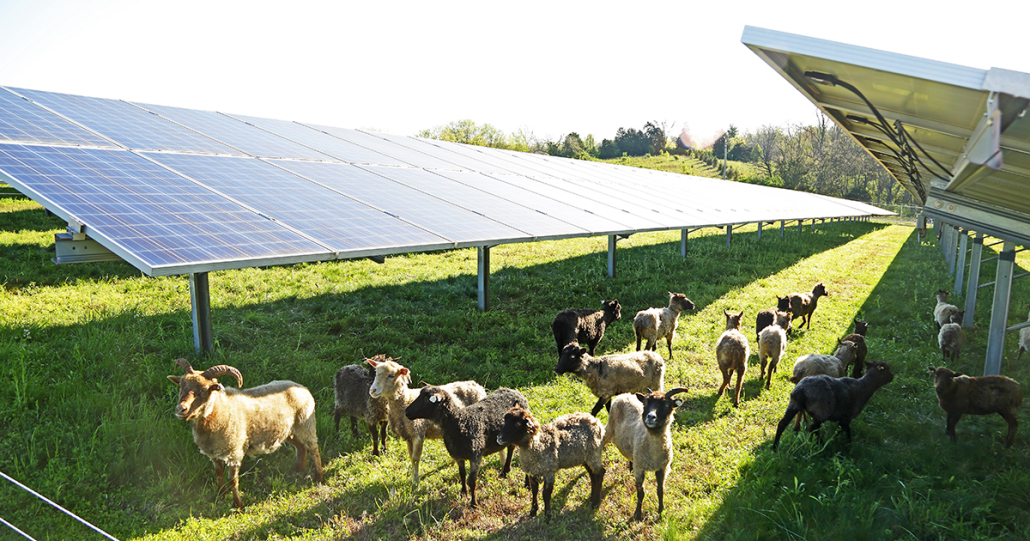
Shaker Hill uses Shetland sheep, a heritage breed, on the E.W. Brown solar site. This breed originates from the highlands of Scotland and was common in the 19th century when the Shakers occupied the Pleasant Hill area. This allows Shaker Hill to connect their farm story directly to the Shaker’s agricultural history. Also, importantly, Shetlands are a smaller breed of sheep, and their size allows them to access the hard-to-reach areas of the solar arrays, whereas a larger breed might not be as efficient in maintaining vegetation growth. Shetlands are also known for their resilience in poor forage conditions, long life span and natural lambing ability.
“We’re happy to provide a green and sustainable way to help care for our neighbor’s land,” said Shaker Village farm manager Michael Moore. “Our farm gravitates toward heritage breeds, like Shetlands, that were raised by the Shakers of Pleasant Hill. This allows us to connect our farm story directly to the agricultural history of this region.”
The 50 sheep moved to the site in April 2023 will graze throughout the spring, summer and fall, and then they will be transported back to the Shaker Village Farm for the winter months.
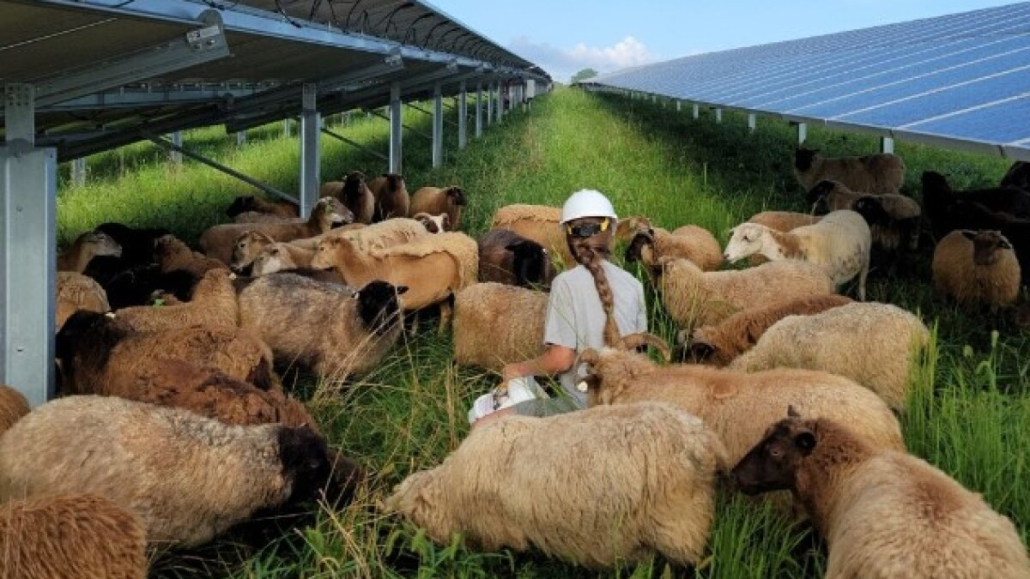
There are also two Anatolian Pyrenees cross-bred dogs on-site that aid in protecting the sheep from predators. The guardian dogs live with and provide protection to the flock year-round. The team at Shaker Village manages the daily care of the dogs.
The successful partnership between Shaker Village, LG&E has inspired the launch of the children’s book, Levi the Lamb’s Big Day. The book follows a sheep named Levi as he grazes a solar facility. The book was written by LG&E and KU manager of Technology Research and Analysis, Aaron Carter, and is available for purchase online or at the Shaker Village Gift Shop.
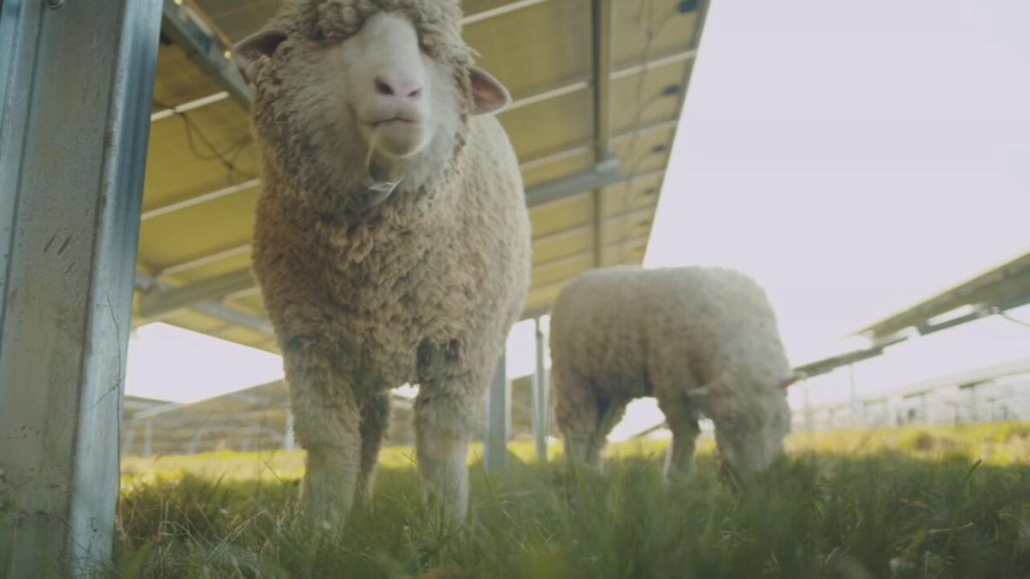
Shaker Village also has a “ewe tube” camera, where people can watch a live feed of the solar array. You can watch the sheep graze the facility here.
